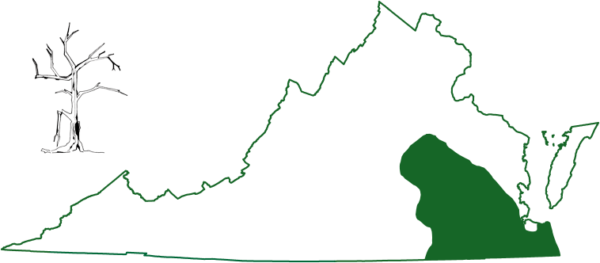Southeastern Bats. © Merlin D. Tuttle, Bat Conservation International.
Southeastern Bat. Illustration by Brittany Fernald.
Fact File
Scientific Name: Myotis austroriparius
Classification: Mammal, Order Chiroptera
Conservation Status:
- Species of Greatest Conservation Need-Tier 4a on the Virginia Wildlife Action Plan
Identifying Characteristics
The southeastern bat is similar in appearance to the little brown bat, but distinguished by slightly shorter, thick, dull, wooly fur. Fur color is variable in this species due to molting and ranges from grayish brown to yellowish above and white or tan below. Adults measure approximately 3.3–3.8 inches in length and weigh 0.2–0.45 ounces.
Habitat
The southeastern bat, like the Rafinesque’s big-eared bat, can be a tree or cave bat depending on geographic location. In Virginia, this species is a tree bat of bottomland hardwood forests in southeast Virginia. Roosts in snags, broken trees, sloughing bark, and tree cavities. In other parts of its range it is closely associated with caves.
Diet
Like the gray bat, the southeastern bat is primarily a riparian feeder flying low over water feeding on insects. Mosquitoes, crane flies, beetles, and moths are some of the food items consumed by the southeastern bat.
Distribution:
The southeastern bat is a relatively new species to Virginia. The first record in Virginia is from 1996 when four male southeastern bats were captured during a survey at the Great Dismal Swamp National Wildlife Refuge.

Breeding Biology
Little is known of the breeding biology of this species outside of populations in Florida. Mating is generally from mid-February to mid-April, and nursery colonies start to form in mid-March. Twins are typically born in late April to mid-May, and young are capable of sustaining themselves in about three weeks. Maternity roosts are generally found in tree cavities and buildings, often associated with streams or ponds.
Conservation
Tier IV Species of Greatest Conservation Need in Virginia’s Wildlife Action Plan. Primary threats are loss and degradation of bottomland hardwood forests. Conservation actions are tied to protection and enhancement of bottomland hardwood forests.
Last updated: August 14, 2024
ShopDWR
Order your copy of A Guide to the Bats of Virginia, along with more gear, guides, and gifts!
Visit ShopDWRThe Virginia Department of Wildlife Resources Species Profile Database serves as a repository of information for Virginia’s fish and wildlife species. The database is managed and curated by the Wildlife Information and Environmental Services (WIES) program. Species profile data, distribution information, and photography is generated by the Virginia Department of Wildlife Resources, State and Federal agencies, Collection Permittees, and other trusted partners. This product is not suitable for legal, engineering, or surveying use. The Virginia Department of Wildlife Resources does not accept responsibility for any missing data, inaccuracies, or other errors which may exist. In accordance with the terms of service for this product, you agree to this disclaimer.

